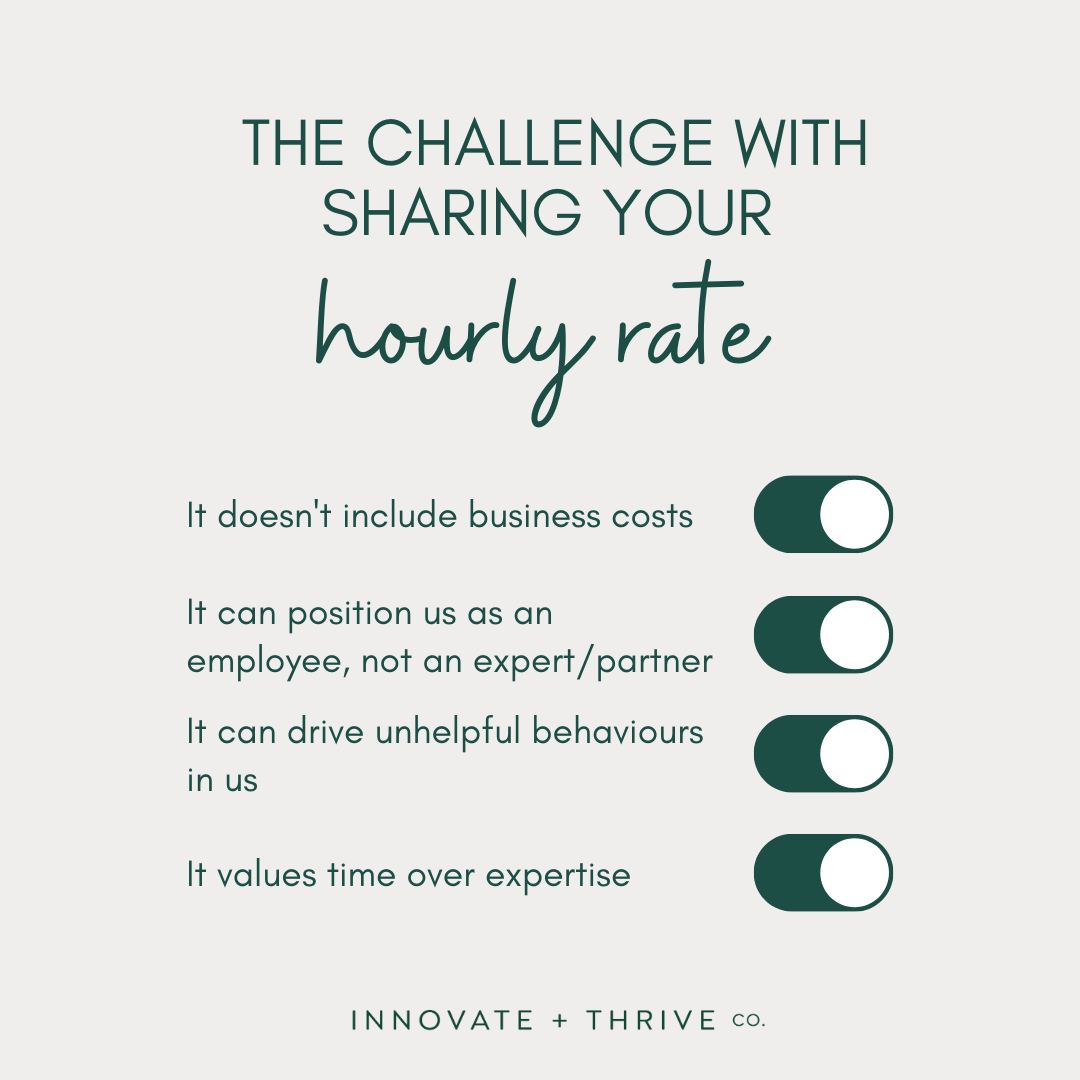

How To Charge For Your Services
If I had a pound for every time I’ve heard a business coach say “charge your worth” I would be a very rich woman. The big, glaring problem with charging your worth is that it simply isn’t very useful advice; for one it’s subjective and secondly it’s not a replicable process you can apply across multiple products or services. Plus, for those who have ever struggled with the abstract idea of their ‘worth’, it can be an incredibly triggering concept. So, here’s a full lowdown on how to charge for your services.
How much should I charge for my services? Start with your ultimate goal (which will look different for all of us) and work backwards: desired turnover / annual billable hours x hours to deliver + expenses + value of impact or transformation = price
Of course, there’s a lot more that goes into it than a simple formula – and that’s what I’m going to dig into in this blog. Read on for my full lowdown on how to price your services, including my exclusive pricing calculator. Alternatively, if you’re ready to dive straight in and transform your pricing strategy, you can take a look at my intensive packages for more information on how I can support you.
Pricing strategies


There are countless strategies when it comes to defining your pricing structure (some more reliable than others!); the magnitude of options is a huge part of the reason many shy away from looking at their pricing in the first place. After all, how do you know which one is the right one for you? What do they all even mean? 🤯
Some of the most popular pricing strategies are:
- Cost-plus pricing
- Marginal cost pricing
- Target ROI pricing
- Experience curve pricing
- Demand based pricing
- Value-based pricing
- Psychological pricing
- Competition-oriented pricing
I know right – get that exploding head emoji out again.
Luckily, you really don’t need to be an expert in every single strategy to understand how much you should be charging for your services. You can start off by familiarising yourself with the core pricing models.
Cost plus pricing
Cost plus pricing is often considered the simplest way to calculate your service pricing. Essentially, it looks at the running cost of a service (or product) and then adds a mark-up to ensure the seller is making a minimum acceptable rate of profit. Running costs may include:
- Direct labour
- Direct materials
- Overheads
It is one of the quickest ways to figure out how much you should charge for your services, as it doesn’t require you to carry out a competitor analysis or customer research; and while saving time is thumbs up for busy business owners, it can limit you and leave you with missed opportunities. Look out for my next blog which will dig into this strategy further.
Value-based pricing
A value-based pricing strategy sets prices primarily (but not exclusively) against the perceived value of a product or service for the customer. So, instead of looking within the company (such as with cost-plus pricing), it focuses on a target market and looks at what they believe the product is worth.
As with all pricing strategies, there are pros and cons of this approach. While on one hand this approach can enable you to charge a higher price point, balance supply and demand and increase brand value, it can also make scalability and the justification of added commodities difficult. In addition, it can be a bit of a ‘finger in the air’ approach, making it tough to finalise. Again, there’s a blog coming on this strategy to give you more information.
Competition oriented pricing
Competition oriented pricing means basing the price of your services on the competition, rather than your own costs or the needs of your customers. In a nutshell, this pricing strategy will see a business owner opting to price their products higher than the competition if:
- They want to be seen as premium or exclusive
- They want to show that their products are considerably higher quality
Or, alternatively, they will price their products lower if:
- They want to be seen as more affordable
- They want to attract clients purely based on their pricing
Again, this isn’t a flawless approach. It takes a passive mindset, and can lead to a business being left out in the cold if they fail to notice that their prices need changing as a result of other factors, including market changes, a twist in consumer needs or wider influences (such as *ahem* a global pandemic). You may also find yourself in the dangerous position of pricing your services too low, leaving your running costs uncovered.
‘How much should I charge?’ calculator
The Innovate & Thrive Co. Service Pricing Strategy aims to eliminate the risks of each approach, and rounds the benefits together in one, easy-to-use method. You can access it by signing up to our mailing list below.
How much should I charge per hour?
I am a strong believer that (in most circumstances) business owners should never communicate their hourly rates to clients; and there are a few reasons why.


- Working by an hourly rate disregards the fact that you are also running a business with operating costs, the need to take holiday and space for day-to-day emergencies and general hiccups.
- This approach can change the relationship with the client from expert/partner to employee. It can encourage the mentality that the client owns your time, which may lead to unachievable (and unwanted!) demands rather than an equal collaboration.
- It can also drive unhelpful behaviours – for example, if you sell a package of three hours, but deliver the project in two hours, do you tell the client that there is a spare hour? Do you offer to do more? Do you carry it over? Alternatively, if you sell a set of deliverables, you avoid that.
- It sells the idea that your time is your only worth, and ignores the benefit of quicker turnaround times the more experienced you are in your offering. For example, something may take you – a business owner with years of experience – one hour to complete to an exceptional standard, but another service provider with far less experience and capabilities five hours. In this case, the less experienced provider could stand to charge more for the service… Which let’s face it, makes NO sense.
However, while I am an advocate for keeping your hourly rate close to your chest, I also think it is important to have it at the forefront of your mind when negotiating packages and prices. This can be a good number to refer back to, especially if you want to plot your break even points for courses and programmes. A useful place to start figuring out an accurate hourly rate is:
Desired turnover / annual billable hours
Pricing Services – Per hour vs package pricing
The first thing I do when working with a new client on their pricing, is to give them the permission to step away from the ‘per hour’ mentality and embrace package pricing. So whilst we use the basic hourly rate calculation to establish a minimum, we then build in market research and transformation for the client.
Market research
this will give you a reasonable idea of your position against competitors, and help you form a base idea of what clients are currently looking for and prepared to pay.
Transformation for the client
consider the impact you are having on your clients. What is that worth to them? Are you providing a transformation to their business? Saving them time or money? Bringing them joy? All of these hold value over and above your time.
I spoke to some of my most recent pricing clients to ask them how the transition into this strategic pricing model has helped their business.
Hayley Griffith, Creatively Hayley “My past approach to pricing could be summed up as a wild stab in the dark, with lots of umms and ermms before pressing send and hiding behind a cushion. Now, I’m pricing with confidence, and my packages are a true reflection of what my services are worth. “I have been able to increase my prices quite dramatically. I’ve also realised that if someone doesn’t want to pay those prices, then that’s fine – whereas before I would drop my prices or offer them extra to fit them, which wasn’t doing me any favours. “It’s changed my business enormously, as I no longer have the stresses and worries that come with pulling my prices out of thin air.”
Laura Fellows, The Streamlined Company “Before working with Innovate + Thrive Co, I was massively underpricing myself. I was plucking figures out of nowhere but now I have a trusted method that lets me know that I’m pricing my services/product for profit. I love being able to follow step-by-step instructions and work out the maths behind it, and then add a bit of “does this feel right?” at the end. This new approach has taken the emotion out of pricing for me: no more “what am I worth?” nonsense. I know what I need to make to cover my costs, what I need to reach my goal life and that I’m actually making a profit.
It also means I can sell my service with confidence – I know what the cost is and state it without second guessing. And I’ve also noticed that the higher I price my service, the less people question the price! Potential clients don’t ask for discounts any more!”
Amber Badger, The Wild Wordsmith “For a long time I priced purely on a ‘per hour’ system (with an hourly rate that was vastly below what I needed to sustain my business) and found myself burning out and getting huge anxiety from my work. Many of my client relationships were incredibly one-sided, and I was treated like an employee – expected to drop all other work at a moment’s notice – rather than an expert that they had hired to support their growth.
Since moving to a package pricing system, my income is exactly where I need it to be and I am working with my dream clients. The respect is mutual, and we are all totally invested in the work at hand. I no longer feel nervous about telling potential clients my pricing, and instead have the mentality that if the pricing doesn’t work for them, then I am not the right person to support their needs… And I’m totally okay with that.”


